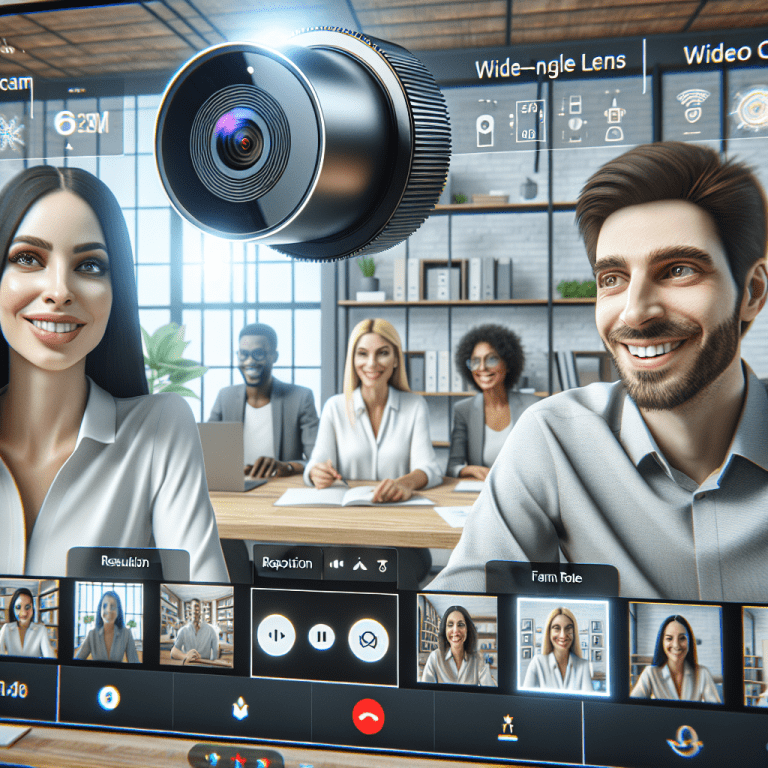video conferencing software has revolutionized the way businesses conduct interviews and recruitment processes, providing a convenient and efficient solution for remote collaboration. Gone are the days of scheduling complicated logistics and travel arrangements for face-to-face meetings. With just a few clicks, businesses can now connect with candidates from all over the world, saving time, money, and resources. This technology allows for real-time communication, enabling employers to gauge a candidate’s qualifications, skills, and cultural fit without the need for in-person interactions. In this article, we will explore the various ways in which businesses can leverage video conferencing software to streamline their interview and recruitment processes, ensuring they find the best talent for their organizations. In today’s technological era, video conferencing software has become an essential tool for businesses to conduct interviews and streamline their recruitment processes. With the advancement of virtual collaboration tools, companies can now connect with candidates from anywhere in the world, saving time and resources. In this article, we will explore the numerous benefits of video conferencing software, provide tips for preparing for video interviews, discuss the interview process, and delve into best practices, challenges, and solutions. We will also touch upon the importance of ensuring fairness and inclusivity, as well as data security and privacy. Lastly, we will explore future trends and innovations that businesses can look forward to in the world of video interviews.
Learn More About O-Connect Here
Benefits of Video Conferencing Software
Improved efficiency and time-saving
Video conferencing software offers businesses the advantage of improved efficiency and significant time-saving. By conducting interviews remotely, companies can eliminate the need for travel and accommodation expenses. This not only saves valuable resources but also allows businesses to rapidly connect with candidates, regardless of their geographical location. Gone are the days of scheduling conflicts and lengthy recruitment processes – video conferencing software enables businesses to streamline their hiring procedures and expedite the decision-making process.
Expanded reach for candidates
One of the most significant benefits of utilizing video conferencing software for conducting interviews is the expanded reach it provides for candidates. Companies can now tap into a global talent pool and consider candidates who would have otherwise been inaccessible due to geographical constraints. This opens up new avenues for businesses to find the most suitable candidates for their organizations, resulting in increased diversity and inclusion in the workplace. By embracing video interviews, companies can broaden their horizons and find talent that might otherwise have been overlooked.
Cost-effective solution
Video conferencing software offers a cost-effective solution for businesses, especially when compared to traditional in-person interviews. With the elimination of travel and accommodation expenses, companies can significantly reduce their recruitment costs. Additionally, video interviews allow businesses to conduct multiple interviews within a shorter timeframe, streamlining the hiring process and minimizing expenses associated with scheduling conflicts. By adopting video conferencing software, companies can make smart financial decisions without compromising on the quality of their recruitment process.
Enhanced communication and collaboration
Video conferencing software facilitates enhanced communication and collaboration between interviewers and candidates. Through video interviews, businesses can establish a face-to-face connection with candidates, fostering a more personal and engaging experience. In addition, features such as screen sharing and virtual whiteboards can be utilized to assess technical skills and collaborate on projects in real-time. By leveraging these tools, businesses can gain a deeper understanding of a candidate’s capabilities, problem-solving skills, and communication style.
Preparing for Video Interviews
Selecting the appropriate video conferencing software
Before diving into the world of video interviews, it is essential to choose the appropriate video conferencing software that suits your business needs. Consider factors such as ease of use, reliability, and features offered by different platforms. Look for software that provides stability, high-quality video and audio, and a user-friendly interface. One reliable and highly recommended option is O-Connect, a robust video conferencing platform that combines advanced features with ease of use, making it an ideal choice for conducting interviews and recruitment processes.
Ensuring reliable internet connection and equipment
To ensure smooth and uninterrupted video interviews, it is crucial to have a reliable internet connection and suitable equipment. Check your internet speed and consider using a wired connection when possible to avoid any connectivity issues. Test your audio and video settings in advance to ensure clear communication and minimize any technical disruptions during the interview. Additionally, make sure you have access to a high-quality webcam and microphone to enhance the overall interview experience.
Creating a professional and well-lit environment
When conducting video interviews, it is vital to create a professional and well-lit environment. Choose a quiet location where you will not be interrupted by external noises. Opt for a clean and clutter-free background to maintain a professional appearance. Ensure that the lighting in the room is adequate, with natural or artificial light illuminating your face evenly. A well-lit environment not only improves visibility but also presents a polished and engaging image to the candidate.
Testing audio and video settings
Before conducting video interviews, take the time to test your audio and video settings. Ensure that your microphone is working correctly, and sound levels are balanced. Adjust your camera angle and frame to achieve optimal visibility. Familiarize yourself with the software’s settings and explore features such as screen sharing or whiteboard if applicable. Conducting a test call or mock interview with a colleague can help identify any issues and ensure a smooth experience during the actual interview.
Sharing interview details and instructions with candidates
To ensure a seamless interview process, it is essential to share interview details and instructions with candidates in advance. Provide them with clear instructions on how to join the video interview, including any specific software requirements or links they need to access. Inform candidates about the estimated duration of the interview and the format it will follow. Sharing this information ahead of time will enable candidates to prepare adequately, ensuring a more productive and engaging interview experience.
The Interview Process
Scheduling and confirming the interview
When it comes to scheduling video interviews, it is crucial to establish clear communication and ensure mutually agreed-upon times. Use reliable scheduling tools or email correspondence to set up interview appointments. Once the interview is confirmed, send a detailed confirmation email to the candidate, including the date, time, and any additional instructions or requirements. This eliminates confusion and ensures that both parties are prepared and ready for the interview.
Establishing rapport and putting the candidate at ease
Creating a comfortable and welcoming environment is vital in video interviews. Start the interview by introducing yourself and expressing enthusiasm for speaking with the candidate. Establish rapport by engaging in small talk and asking open-ended questions to put the candidate at ease. Display active listening skills and provide positive reinforcement throughout the interview. By creating a friendly and welcoming atmosphere, you can encourage open and honest communication with the candidate.
Conducting structured and standardized interviews
To ensure fairness and consistency in the interview process, it is essential to conduct structured and standardized interviews. Prepare a set of questions or an interview script in advance to maintain a consistent approach with each candidate. Use a scoring system or rubric to assess candidates objectively, focusing on key qualifications and competencies required for the role. Standardization helps in comparing candidates fairly and making informed hiring decisions.
Using screen sharing and virtual whiteboards for technical assessments
Video conferencing software offers unique features such as screen sharing and virtual whiteboards that can be utilized for technical assessments. For candidates applying for roles that require specific technical skills, utilize screen sharing to assess their practical knowledge. Candidates can demonstrate their capabilities by sharing their screen and performing tasks relevant to the job. Similarly, virtual whiteboards can be used for collaborative problem-solving exercises or brainstorming sessions, allowing candidates to showcase their creativity and teamwork skills.
Assessing non-verbal cues and body language
While video interviews may lack physical presence, it is still possible to assess non-verbal cues and body language. Pay attention to the candidate’s facial expressions, gestures, and posture throughout the interview. These cues can provide insights into their level of engagement, confidence, and communication skills. However, it is essential to remember that cultural differences may influence non-verbal cues, so approach this aspect of the interview with cultural sensitivity and open-mindedness.
Engaging and Evaluating Candidates
Utilizing virtual backgrounds and branding opportunities
Virtual backgrounds can be an excellent tool for engaging candidates during video interviews. Consider utilizing branded virtual backgrounds to create a visually appealing and professional setting. Branded backgrounds not only showcase your company’s identity but also make the interview experience memorable for candidates. Furthermore, virtual backgrounds can be utilized to set the stage for discussions related to the company’s values, mission, or specific projects, creating a more immersive and engaging experience.
Using breakout rooms for group discussions or team assessments
Video conferencing software often provides the option of breakout rooms, which can be utilized for group discussions or team assessments. Instead of individual interviews, consider conducting group discussions with multiple candidates to assess their collaboration and communication skills. Breakout rooms allow candidates to interact with each other and engage in meaningful discussions or problem-solving exercises. This approach not only provides valuable insights into a candidate’s teamwork abilities but also simulates real-life scenarios they may encounter within the company.
Applying interactive features to gauge candidate engagement
Interactive features offered by video conferencing software can be used to gauge candidate engagement. Take advantage of polling, chat features, or interactive presentations to encourage candidate participation and gather instant feedback. Conducting real-time polls or surveys enables candidates to voice their opinions, contributing to a more inclusive and interactive interview process. Additionally, interactive presentations can be used to assess a candidate’s ability to present information effectively or demonstrate their understanding of specific topics related to the role.
Recording interviews for later review and evaluation
Recording video interviews is a valuable practice for later review and evaluation. By recording the interviews, you can closely analyze candidate responses, assess their suitability for the role, and compare different candidates objectively. Additionally, reviewing the recorded interviews allows for a more detailed evaluation and consistency in the decision-making process, especially when multiple individuals are involved in the recruitment process. However, it is crucial to obtain the candidate’s consent before recording and storing any interview footage, ensuring compliance with privacy and data protection regulations.
Ensuring Fairness and Inclusivity
Providing equal opportunities for remote candidates
In a remote working environment, it is essential to provide equal opportunities for all candidates, regardless of their location. Embrace video conferencing software to connect with remote candidates, ensuring that they are not disadvantaged in the interview process. Establish clear communication channels and offer flexibility in scheduling interviews to accommodate different time zones. By providing equal opportunities, businesses can broaden their talent pool and promote diversity and inclusion within their organizations.
Minimizing biases in the recruitment process
Conducting video interviews can help minimize biases in the recruitment process. By removing physical appearance as a primary factor, businesses can focus on a candidate’s qualifications, experience, and skills. Ensure that interviewers are trained on unconscious biases and possess the necessary skills to evaluate candidates objectively. Implement standardized interview questions and evaluation criteria to reduce subjective biases. Leveraging video conferencing software allows businesses to prioritize meritocracy and make fair hiring decisions based on candidates’ abilities rather than extraneous factors.
Making reasonable accommodations for candidates with disabilities
Video conferencing software enables businesses to make reasonable accommodations for candidates with disabilities. Ensure that the chosen software is accessible and compatible with assistive technologies, allowing candidates with visual or hearing impairments to participate fully. If a candidate requires additional support or accommodations during the interview, listen to their needs and provide appropriate assistance. By embracing inclusivity and accessibility, businesses can tap into the talents and skills of individuals with diverse abilities.
Data Security and Privacy
Choosing secure video conferencing software
Data security and privacy are paramount when conducting video interviews. Choose video conferencing software that prioritizes security and implements robust encryption measures. Look for software providers that comply with industry standards, such as General Data Protection Regulation (GDPR) or the Health Insurance Portability and Accountability Act (HIPAA), if applicable to your business. Conduct thorough research to ensure that the chosen software protects sensitive candidate information and provides secure data transfer.
Implementing encryption and authentication measures
To safeguard data during video interviews, it is vital to implement encryption and authentication measures. Ensure that the software utilizes end-to-end encryption, which protects communication from being intercepted or accessed by unauthorized parties. Additionally, use secure authentication methods such as unique meeting IDs or passwords to prevent unauthorized access to interview sessions. By incorporating these measures, you can ensure the confidentiality and integrity of candidate data.
Managing data storage and retention
Businesses must have clear guidelines for data storage and retention when utilizing video conferencing software. Establish a policy that outlines how long interview recordings or related data will be stored and the purpose for which it will be used. Adhere to applicable privacy laws and regulations when handling candidate information. Data should be stored securely and disposed of appropriately once it is no longer needed. By implementing effective data management practices, businesses can demonstrate integrity and respect for candidate privacy.
Obtaining consent for recording and storing interviews
Prior to recording and storing video interviews, it is crucial to obtain consent from candidates. Communicate this requirement to candidates and provide them with the necessary information regarding the purpose and duration of the recording. Make the consent process transparent and easily understandable, ensuring that candidates have the opportunity to ask questions or request modifications to the process. Obtaining consent not only fosters trust between businesses and candidates but also strengthens compliance with data protection regulations.
Best Practices for Video Interviews
Preparing an interview script or set of questions
To ensure a structured and organized interview, it is advisable to prepare an interview script or set of questions in advance. This not only provides consistency but also ensures that all relevant topics are covered. Tailor the questions to assess specific skills, experiences, and qualifications required for the role. Additionally, design questions that prompt candidates to provide specific examples or solutions, allowing you to evaluate their problem-solving abilities effectively.
Maintaining a professional demeanor and body language
During video interviews, it is crucial to maintain a professional demeanor and body language. Dress appropriately, just as you would in a traditional in-person interview, to create an atmosphere of professionalism. Maintain eye contact by looking directly into the camera, rather than at your own video feed. Sit up straight and exhibit attentive body language to convey interest and engagement. By projecting professionalism through your demeanor and body language, you create a positive impression and establish authority.
Actively listening and avoiding distractions
Active listening plays a significant role in video interviews. Practice active listening skills by giving your full attention to the candidate and demonstrating genuine interest in their responses. Avoid distractions such as checking emails or multitasking during the interview. Give candidates the opportunity to express themselves fully and articulate their thoughts without interruption. By actively listening and avoiding distractions, you create a supportive and engaging environment for the candidate.
Taking notes and documenting feedback
Taking notes and documenting feedback during video interviews is essential for later evaluation and comparison of candidates. Use an organized note-taking system to capture important details and key takeaways from the interview. Record observations about the candidate’s qualifications, skills, and overall compatibility with the role and company culture. These notes will serve as a valuable resource when making hiring decisions and providing feedback to candidates.
Providing clear instructions for next steps
At the conclusion of the video interview, provide the candidate with clear instructions regarding the next steps in the recruitment process. Communicate the timeline for further evaluations or assessments, and let them know when they can expect to hear back from you. Be transparent about the next stages of the hiring process, such as additional interviews or reference checks. Providing clear instructions establishes a sense of structure and ensures that candidates are aware of what to expect moving forward.
Challenges and Solutions
Technical difficulties and troubleshooting
Technical difficulties can pose challenges during video interviews. To mitigate potential issues, perform thorough checks of your internet connection, software settings, and equipment beforehand. Test your audio and video capabilities to ensure smooth communication. Familiarize yourself with troubleshooting methods, such as reconnecting to the meeting or restarting your device. In the event of technical issues during the interview, remain calm and professional, and communicate the problem to the candidate. If necessary, reschedule the interview to a more convenient time to ensure a smooth experience for both parties.
Overcoming the lack of in-person interaction
The lack of in-person interaction in video interviews can be challenging, as physical cues are limited. To overcome this obstacle, focus on building meaningful connections through active listening and engagement. Ask open-ended questions that allow candidates to elaborate on their experiences and provide examples. Encourage candidates to ask questions or seek clarification during the interview, fostering a sense of interaction and conversation. By proactively addressing the absence of in-person interaction, you can create an environment that encourages open communication and effective evaluation.
Managing time zones and scheduling conflicts
In a globalized world, managing time zones and scheduling conflicts can be a challenging aspect of video interviews. Prioritize effective communication and clarity when scheduling interviews, ensuring that both parties fully understand the proposed time and date. Consider offering flexible time slots to accommodate candidates in different time zones. Utilize scheduling tools or apps that display time zone conversions, making it easier to coordinate interview appointments. By managing time zones and scheduling conflicts efficiently, you can maintain a smooth and efficient interview process.
Building rapport and establishing connection remotely
Building rapport and establishing a connection remotely can be a bit more challenging compared to in-person interviews. However, there are strategies to overcome this hurdle. Start the interview by expressing genuine interest in the candidate and creating a friendly and welcoming atmosphere. Engage in small talk to establish a personal connection and put the candidate at ease. Utilize active listening and respond empathetically to foster a sense of connection. By consciously building rapport, you can create a positive and engaging environment.
Click to Learn More
Training and Onboarding
Educating interviewers and hiring managers on video interviewing techniques
To ensure a successful video interviewing process, it is crucial to educate interviewers and hiring managers on the specific techniques required for virtual interviews. Provide comprehensive training on how to effectively utilize video conferencing software, manage technical issues, and assess candidates remotely. Share best practices for creating an engaging interview experience through virtual platforms. By equipping interviewers and hiring managers with the necessary knowledge and skills, businesses can optimize their recruitment process and make informed hiring decisions.
Providing guidelines for remote panel interviews
Remote panel interviews bring multiple interviewers together virtually to assess candidates. Providing guidelines for remote panel interviews helps maintain consistency and structure during the interview process. Establish clear roles and responsibilities for each panel member, ensuring equal participation and engagement. Set expectations regarding the evaluation criteria and scoring system to enhance objectivity. Provide guidelines for minimizing interruptions and allowing candidates ample time to respond to questions. By establishing guidelines, businesses can ensure a smooth and effective remote panel interview experience.
Conducting mock interviews and simulations
Mock interviews and simulations are invaluable tools for preparing interviewers and enhancing their skills. Schedule practice sessions where interviewers can conduct mock interviews and simulate different scenarios. This helps them familiarize themselves with the video conferencing software, fine-tune their questioning techniques, and develop their ability to assess candidates effectively. Simulations allow interviewers to rehearse their communication style and ensure a smooth and professional interview experience. By conducting mock interviews and simulations, interviewers can build confidence and improve their performance during actual interviews.
Introducing new hires to remote work practices
For businesses that utilize video conferencing software, it is important to introduce new hires to remote work practices. Provide comprehensive onboarding programs that familiarize new employees with the virtual collaboration tools used within the organization. Train them on how to effectively communicate, collaborate, and navigate the software. Offer resources and guidelines for managing remote work environments, including tips for staying productive and maintaining work-life balance. By facilitating a smooth transition into remote work, companies can support the integration of new hires and ensure a successful onboarding experience.
Future Trends and Innovations
Artificial intelligence in video interviews
Artificial intelligence (AI) is set to revolutionize video interviews and recruitment processes. AI-powered video interviewing platforms can analyze facial expressions, vocal tone, and body language to provide insights into candidate suitability. This technology can assist in evaluating soft skills and assessing compatibility with company culture. AI algorithms can also analyze recorded interviews, saving valuable time in the initial screening process. As AI continues to evolve, it holds the potential to streamline recruitment and enhance decision-making.
Virtual reality for immersive assessment experiences
Virtual reality (VR) is emerging as a game-changer in the world of video interviews. VR platforms allow organizations to create immersive assessment experiences that closely replicate real-life environments. Candidates can complete tasks or scenarios designed specifically for the role they are applying for, providing a more comprehensive evaluation of their abilities. VR-based interviews also allow companies to assess a candidate’s adaptability and problem-solving skills in a realistic setting. As VR technology evolves, businesses can expect more engaging and immersive interview experiences.
Integration with applicant tracking systems (ATS)
Integration between video conferencing software and applicant tracking systems (ATS) is a future trend that promises to streamline recruitment processes further. By seamlessly integrating video interview data into ATS, businesses can centralize candidate information, track progress, and evaluate suitability for multiple positions. This integration reduces manual data entry, enhances data integrity, and simplifies administrative tasks. Companies can efficiently manage their recruitment pipeline and make more informed decisions by leveraging the synergy between video conferencing software and ATS.
Advancements in virtual backgrounds and augmented reality
Virtual backgrounds and augmented reality (AR) are poised to become more sophisticated and realistic. As technology advances, businesses can expect enhanced visuals, allowing for lifelike and immersive backgrounds during video interviews. AR integration may enable candidates to digitally interact with virtual objects or demonstrate skills in a virtual environment. These advancements will elevate the overall interview experience, providing candidates with a more engaging and dynamic assessment process. Businesses can leverage these innovative tools to attract top talent and differentiate themselves in the competitive hiring landscape.
In conclusion, video conferencing software has revolutionized the way businesses conduct interviews and streamline their recruitment processes. It offers improved efficiency, expanded reach for candidates, cost-effective solutions, enhanced communication, and collaboration. By following best practices, ensuring fairness and inclusivity, prioritizing data security and privacy, and embracing future trends and innovations, businesses can harness the full potential of video interviews and attract the best talent to drive their growth and success.
Try Our 14 Day Free Trial Offer









